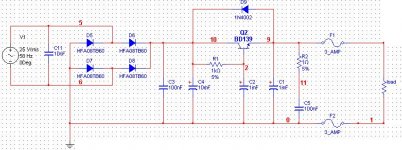Hi guys
I'm wanting to experiment with higher capacitance power supplies for my chipamp. I only have limited space in my chassis.
I've been looking into a simple capacitance multiplier PSU
Has anyone tried this setup with chipamps ?
i was hoping to use this layout for both +ve and -ve
I'm wanting to experiment with higher capacitance power supplies for my chipamp. I only have limited space in my chassis.
I've been looking into a simple capacitance multiplier PSU
Has anyone tried this setup with chipamps ?
i was hoping to use this layout for both +ve and -ve
Attachments
well the same layout would be used for the +ve and -ve.
each will have their own bridge, the -ve would be taken from the gnd side relative to the +ve side.
2 fuses are used as extra protection (eg. reverse polarity) for my own benefit .
each will have their own bridge, the -ve would be taken from the gnd side relative to the +ve side.
2 fuses are used as extra protection (eg. reverse polarity) for my own benefit .
replace R1 C2 with an RCRC filter.
510r+220uF and 510r+220uF will perform far better than 1000r+1000uF.
Add a resistor in parallel to the last C of this filter.
Use the value of this resistor to adjust the amount of ripple that the multiplier can attenuate.
A low value resistor will pull down the output voltage and give a higher voltage drop across the pass transistor. This voltage drop is the maximum ripple that the multiplier can attenuate.
A higher resistor will give a higher output voltage, but the ripple will leak through as the current is increased.
Your resistor is effectively infinity and tiny output currents will show ripple passing straight through the multiplier.
The really big advantage of the multiplier is that the rough smoothing cap can be made much smaller. You ignored this advantage by fitting 10mF. Try 1mF or 2m2F instead.
510r+220uF and 510r+220uF will perform far better than 1000r+1000uF.
Add a resistor in parallel to the last C of this filter.
Use the value of this resistor to adjust the amount of ripple that the multiplier can attenuate.
A low value resistor will pull down the output voltage and give a higher voltage drop across the pass transistor. This voltage drop is the maximum ripple that the multiplier can attenuate.
A higher resistor will give a higher output voltage, but the ripple will leak through as the current is increased.
Your resistor is effectively infinity and tiny output currents will show ripple passing straight through the multiplier.
The really big advantage of the multiplier is that the rough smoothing cap can be made much smaller. You ignored this advantage by fitting 10mF. Try 1mF or 2m2F instead.
- Status
- Not open for further replies.
